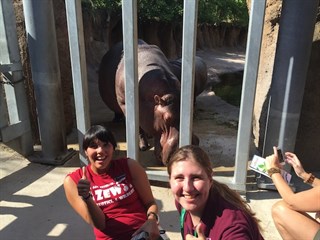I am now only a week and a half away from starting my clinical year! Because our clinical year is so busy, fourth-year students do not serve as ambassadors, which means I will be leaving the team as both a member and its leader. While reflecting on my first three years of veterinary school, I remembered my blog post from first year that summarized my advice for veterinary school. These lessons were helpful to me in my second and third year and will continue to serve me well in my final year of veterinary school.
If I could give one final piece of advice for succeeding in veterinary school, I would say that success in veterinary school is determined as much by your attitude as by your knowledge and experience. With that in mind, below is a list of five personality traits that I believe are valuable in veterinary school:
- Resilience: Veterinary school is full of challenges, both academically and emotionally. My classmates and I all have had to deal with obstacles of different magnitudes while in veterinary school, whether the setback was failing a course, coping with a family crisis, or managing responsibilities while ill. Resilience is the strength to keep persevering through four difficult years even in times when it seems impossible to become a successful veterinarian.
- Adaptability: Being adaptable is a key part of resilience. Veterinary medicine is constantly changing and veterinary school constantly presents its own challenges. This year we had to adapt to a completely new Veterinary Biomedical Education Complex. Next year’s incoming first-year class will have a completely redesigned curriculum. Fourth year is the epitome of change during veterinary school—fourth-year students change rotations within the hospital every two weeks, and each service has its own rules and structure.
- Loyalty: It is far better to face the challenges of veterinary school united. Support your classmates through their struggles by sharing resources and offering help. This will be especially important during fourth year, when students share cases and patient care. Always remember that your classmates and professors will be your future colleagues.
- Confidence: It is sometimes hard for me to feel confident during veterinary school. However, confidence is needed to pursue opportunities and make the most out of a veterinary-school education. Because I was confident enough to apply, I had amazing experiences, such as spending three weeks working at a macaw conservation project in the Peruvian rainforest and serving as a leader in several student organizations, including CVM Ambassadors.
- Open-mindedness: Veterinary medicine is constantly evolving thanks to new advances in research. It is impossible to be an expert in everything, especially as a student. Be humble and willing to learn from others.
I hope that this advice is helpful, no matter where you are on your veterinary school journey. I have loved my time in veterinary school so far, and I am excited for next year!

 First semester of the second year of vet school had an interesting start! On the first day of classes I introduced myself to my professors by asking for permission to miss classes to attend a veterinary conference. Since I want to work in small animal and exotics clinical practice after graduation, attending ExoticsCon was a great choice.
First semester of the second year of vet school had an interesting start! On the first day of classes I introduced myself to my professors by asking for permission to miss classes to attend a veterinary conference. Since I want to work in small animal and exotics clinical practice after graduation, attending ExoticsCon was a great choice.